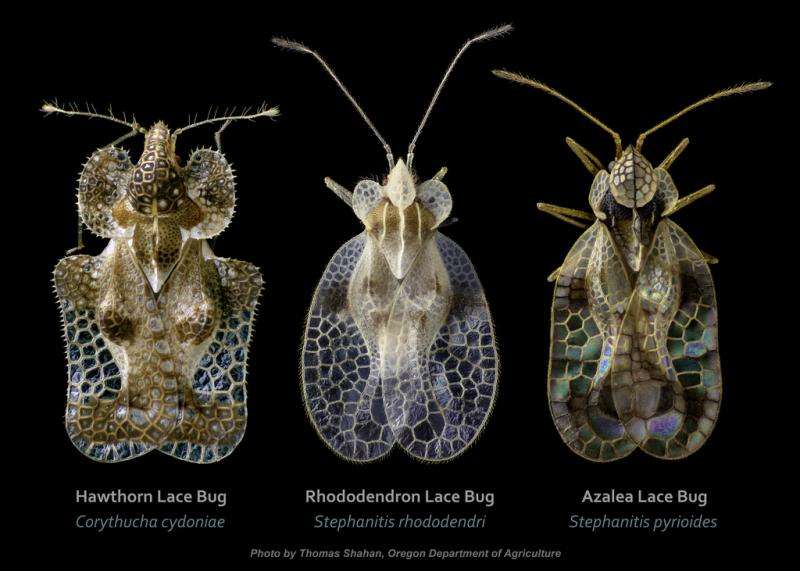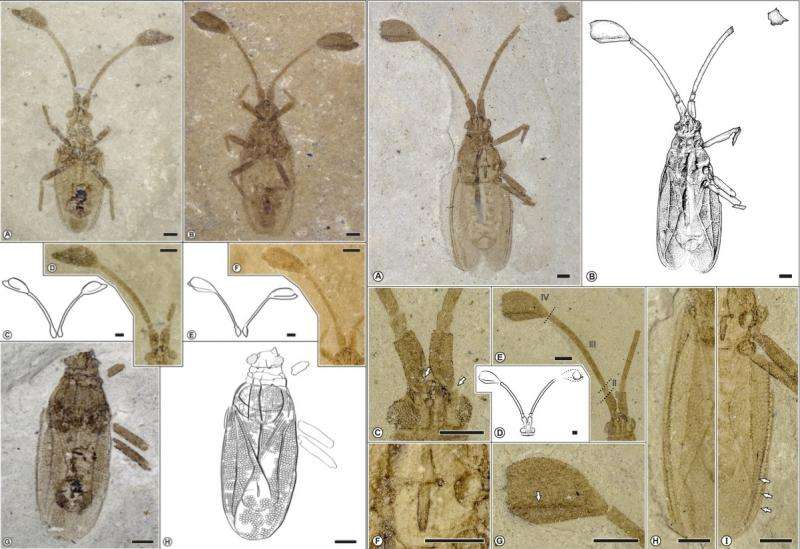A new fossil lace bug with unusual antennae joins the "big" club

Have you ever seen a lace bug? Don't let their pretty name fool you—even though they're dainty as a doily, they're tough little bugs. You may have encountered lace bugs in your garden or on houseplants, since they're herbivorous sap-drinkers. Though they only feed on plants, their bite can sting!
Named for their translucent delicate wings, as seen above, little lace bugs make up the big family Tingidae within the order Hemiptera. Currently, there are over 2100 species of lace bugs living all over Earth. This globetrotting goes way back: Places as diverse as the Dominican Republic, Paris, and Myanmar all have amber deposits containing lace bug fossils from millions of years ago.
Most recently, as described in a study in PLOS ONE, scientists found four male lace bugs in the Eocene Green River Formation, a group of basins with exceptional fossil deposits in Colorado, Utah, and Wyoming.
These fossilized lace bugs are unusual for their remarkable preservation and flashy golf club-shaped antennae.
Their unusual antennae led the authors to suspect that they had a totally new species of lace bug on their hands. It can be difficult to categorize a new species, though–especially when looking at fossils.Time renders DNA, proteins, and other biological material low quality, making it often impossible to use common genetic or molecular tools.
Using phylogenetic analysis, which enables researchers to look at evolutionary links between organisms to determine relationships between ancestors and descendants, the authors were still able to assess the relationship of these fossils with other living and fossilized Tingidae species. In this case, instead of using genetic material, the authors compared physical characteristics of these fossils with other known Tingidae specimens.
The results of this detective work? The authors classified these fossils as a new species, Gyaclavator kohlsi. Since it's hard to miss the antennae on these guys, the authors constructed their genus name from a combination of the terms Gyas, who was a mythical giant from the Aeneid, and clavator, Latin for "club".
The authors of this study suspect Gyaclavator's showy antenna may be a rare fossil example of a visual display structure that could have played a role in mate attraction. In other words, Gyaclavator might have used its antennae like a male peacock uses its striking tail feathers: to advertise its appeal as a capable, healthy mate.
The authors also speculate that Glaclavator may have used its antennae as part of male-male competition, in the same way that male deer fight over resources using their antlers. Scientists have not found any other examples of lace bugs from the present or past that have features like these spectacular antennae.
However, other Hemiptera members do show similar enlarged physical structures akin to Gyaclavator's fancy antennae. Some species of leaf-footed bugs from the Coreidae family, for example, have large, petal-shaped antennae segments. They wave their conspicuous antennae through the air as part of a display that seems to function both in courtship as well as male-male competition. You can watch a movie showing a leaf-footed bug strutting his stuff here:

More information: Torsten Wappler et al. Morphological and Behavioral Convergence in Extinct and Extant Bugs: The Systematics and Biology of a New Unusual Fossil Lace Bug from the Eocene, PLOS ONE (2015). DOI: 10.1371/journal.pone.0133330
Journal information: PLoS ONE
Provided by Public Library of Science
This story is republished courtesy of PLOS Blogs: blogs.plos.org.



















